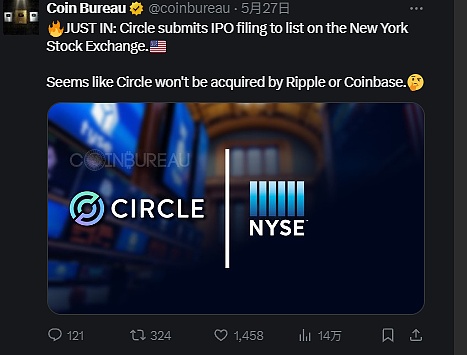Circle plans to be listed on the New York Stock Exchange (NYSE) in the United States on June 5, 2025, with the stock code CRCL. This is not only the first IPO (initial public offering) in the field of stablecoins, but also an important milestone in the integration of digital finance and traditional finance. As the issuer of USDC, the world's second largest dollar-pegged stablecoin, Circle's listing will inject new vitality into the stablecoin market and promote the further development of the tokenization of real-world assets (RWA). This article will deeply analyze the significance of Circle's IPO, the prospects of the stablecoin market, and the global trend of RWA.

1. Circle: The rise from a startup to a stablecoin giant
In 2013, Jeremy Allaire and Sean Neville co-founded Circle, which initially focused on exploring blockchain technology. What really made Circle rank among the top in the industry was the USD stablecoin USDC launched in 2018 in collaboration with Coinbase. With its 1:1 USD reserve guarantee and its ultimate pursuit of compliance and transparency, USDC quickly became an important force in the stablecoin market.
In 2023, the Centre Alliance was dissolved, and Circle took over the issuance and management of USDC. As of April 2025, the market value of USDC has reached 60.9 billion US dollars, ranking second in the world's second largest dollar stablecoin, second only to USDT.
Second, the motivation for listing: the strategic awakening of the Silicon Valley Bank crisis
The Silicon Valley Bank incident in 2023 was an important turning point in the development of Circle. At that time, Circle's 3.3 billion US dollars in reserves in the bank were once "frozen", resulting in a rare depegging of USDC. This crisis made Circle deeply aware that in order to remain invincible in the global stablecoin competition, it is far from enough to rely solely on the support of the crypto community. It must also have the three core weapons of "compliance license + listing status + extreme transparency".
III. IPO details: Institutional enthusiasm, valuation exceeds US$6 billion
According to the latest disclosure by Circle:
Issuance scale: Planned issuance of 24 million shares (9.6 million new shares + 14.4 million old shares)
Pricing range : USD 24-26 per share
Amount of funds raised: Target financing is approximately USD 600 million
Company valuation: Based on the middle price, the fully diluted market value will reach USD 6.2 billion
Subscription by celebrity institutions: ARK Invest (Cathay Wood) has clearly stated that it will subscribe for up to USD 150 million
Top investment banks such as JPMorgan Chase and Citigroup served as underwriters for this IPO.
Fourth, why is listing so important? In-depth interpretation of industry impact
1. Promote mainstream financial acceptance of stablecoins
Guosheng Securities pointed out that Circle's successful listing will significantly accelerate the recognition and adoption of stablecoins by traditional financial institutions (especially large asset management companies). As the "infrastructure" of the cryptocurrency market, stablecoins provide core functions of value storage, transaction pricing and margin. Their mainstreaming will open up trillions of incremental space.
2. Stablecoin: The core bridge between traditional finance and crypto ecology
Stablecoin is essentially the on-chain tokenization of fiat currency assets, combining price stability with the advantages of blockchain technology. In recent years, its application scenarios have rapidly expanded from encrypted transactions to traditional financial fields such as cross-border payments and foreign exchange savings. With its point-to-point high efficiency, low cost and stable currency value, it has become a new choice for international payments.
3. Accelerator of RWA (real world asset) tokenization
Stablecoin provides a key transaction medium for RWA. The total market value of global stablecoins has exceeded US$250 billion (as of May 31, 2025), of which USDT (153 billion) and USDC (61 billion) account for more than 85%. Circle's listing will further strengthen the dominant position of US dollar stablecoins in the RWA ecosystem.
V. Global supervision and RWA implementation process accelerated
Overseas dynamics
The United States and Europe are actively promoting stablecoin legislation in order to compete for global digital payment dominance. Institutions such as BlackRock and Robinhood are pushing high-performance chains such as Solana as RWA infrastructure, and technology integration continues to deepen.
Chinese Practice
Policy support: The Action Plan for High-Quality Development of Digital Finance explicitly supports RWA innovation; the Hong Kong Stablecoin Ordinance was officially gazetted and took effect on May 30, and the regulatory framework was implemented.
Project acceleration: Langxin Group & Ant Digital (new energy), GCL Energy & Ant Digital (photovoltaic), Dalian Digital Island, Shanghai Zuo'an Xinhui (Malu Grape), and Xunying Group (battery swap assets) and other RWA projects have been substantially promoted. Yuanlong Yatu explores the digitalization of cultural assets overseas.
Brokerage firm views
CITIC Securities: The Hong Kong Stablecoin Act will promote the implementation of RWA projects of mainland enterprises in Hong Kong, which is beneficial to financial technology companies with experience in cross-border settlement of digital RMB.
West China Securities: RWA is the core hub connecting the real economy and digital finance. In the future, it will extend to carbon assets, supply chains, intellectual property rights and other scenarios. The integration of AI+on-chain models is expected to activate trillions of asset liquidity.
Circle's listing is not only a rite of passage for the stablecoin industry, but also marks the in-depth advancement of blockchain finance into the mainstream capital market. When the "crypto world settlement layer" is integrated into the traditional financial bloodline, a new era that connects virtual and real and links global assets is accelerating.
The stablecoin battlefield is on fire again. Who will be the winner of the next generation of financial infrastructure?
 Jixu
Jixu







